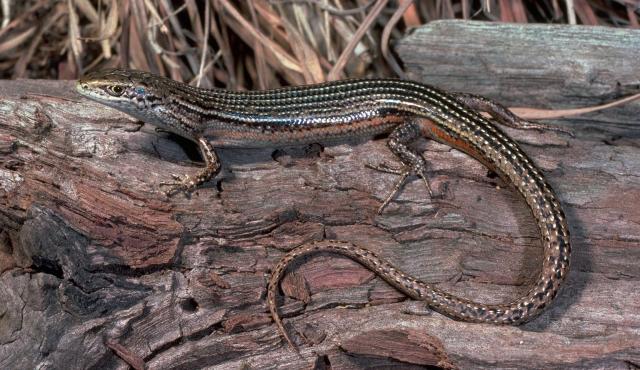A range of teacher professional learning programs will be developed to accompany the Biodiversity of the Western Volcanic Plains online outreach...

Tussock Skink
Pseudemoia pagenstecheri
Active by day. Viviparous (live young). Females give birth to a maximum of 11 live young in late summer.
| Details | Description |
| Type | Reptile |
| Group | Lizard |
| Other Common Names | Southern Grass Tussock Skink, Southern Tussock Grass Skink |
| Identifying Characteristics | |
| Distinctive Markings | Thin, pale stripe runs from behind the ear to the tail. |
| Diet | Carnivore. Opportunistic arthropod feeder including spiders, crickets, larvae and adult moths and beetles. |
| Habitat | Found from the Grampians in the west through the basalt plains west of Melbourne to north-east Victoria. |
| Native Status | Native to Australia |
| Taxonomy | |
| Phylum | Chordata |
| Class | Reptilia |
| Order | Squamata |
| Family | Scincidae |
| Genus | Pseudemoia |
| Species | pagenstecheri |

Distribution maps indicate current and historic locations where species have been sighted.
Source: Atlas of Living Australia
| Conservation Status | |
| DEPI Advisory List | Vulnerable |
| FFG Act | Not listed |
| EPBC Act | Not listed |
The conservation status of species is listed within Victoria and Australia.
The Department of Environment and Primary Industry (DEPI) Advisory List consists of non-statutory advisory lists of rare or threatened flora and fauna within Victoria.
The Flora and Fauna Guarantee Act 1988 (FFG Act) lists threatened species in Victoria. Under the Act, an Action Statement is produced for each listed species.
The Environment Protection and Biodiversity Conservation Act 1999 (EPBC Act) is the Australian Government’s key piece of environmental legislation, listing nationally threatened native species and ecological communities.



